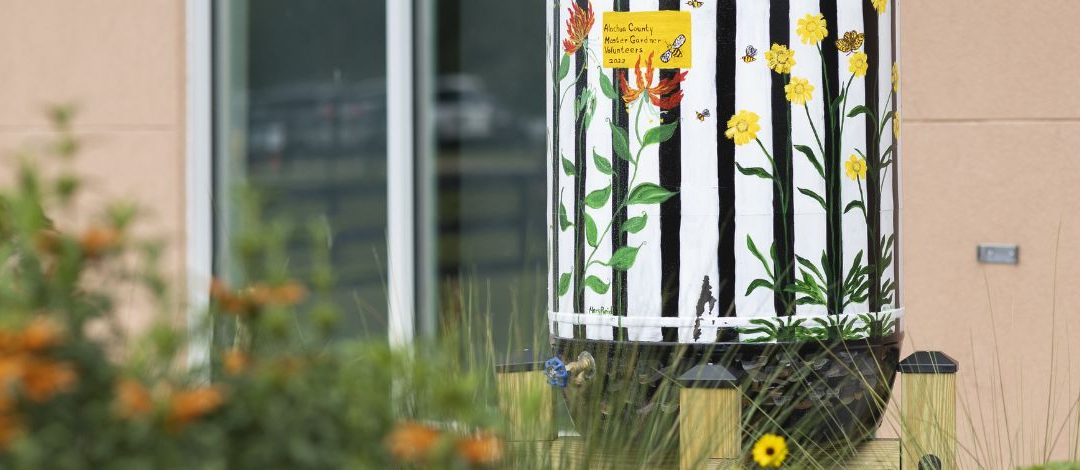
by Abbey Smith | Jul 3, 2024
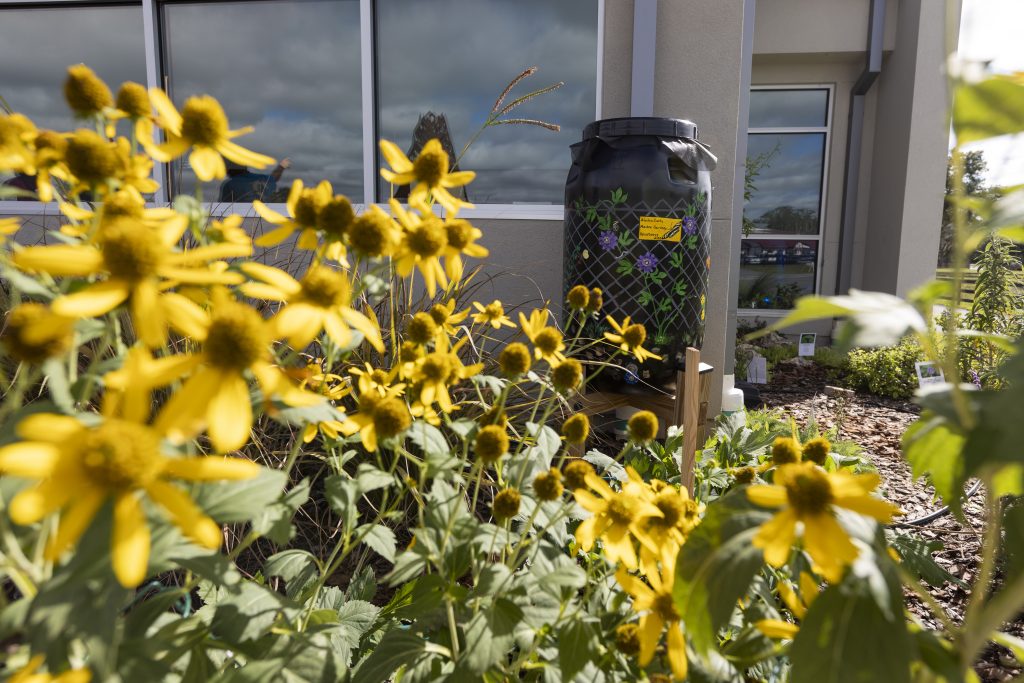
Rain barrel at the teaching demonstration gardens at the Alachua County Extension Office. Photo Credit: Tyler Jones, UF/IFAS
Water is one of the most valuable natural resources and with the ever growing concern of climate change and the hot dry conditions Northwest Florida has already experienced this summer, every drop counts. One way you could combat this issue is by installing a rain barrel at your home. By having a rain barrel on hand, you can reduce stormwater runoff, potentially save money, and improve the health of your plants. Here’s what you need to know:
What is a rain barrel? A rain barrel is a container or storage tank that collects runoff water from a catchment area (a rooftop). They are typically placed under downspouts and capture the water runoff from your home’s gutters. The type of container used to make a rain barrel could be any type, but it cannot have stored chemicals prior to its use as a rain barrel.
Now that we know the definition, why exactly do people use rain barrels? For one, they aid in water conservation. Rain barrels help reduce the amount of potable water used for outdoor purposes, which is important during dry weather spells and areas known for drought conditions. There are also potential cost savings with using a rain barrel. By using the collected rainwater for watering your garden, cleaning outdoor surfaces, or even washing your car, homeowners could potentially reduce their water bills significantly. Having a rain barrel is also a Florida-Friendly way to gardening. Rain barrel usage co-aligns with the Florida-Friendly Landscaping Principles #2: Water Efficiently and #8: Reduce Stormwater Runoff. The use of rain barrels also aligns with sustainable living. It reduces the reliance on municipal water systems and promotes awareness of water usage and conservation.
To install a rain barrel, you will need to obtain a container or “barrel” that is several gallons large to store the water. You can purchase or make one yourself! It will need a secure lid to prevent debris and insects from getting inside. The barrel will need to be placed under a downspout from your home’s roof gutter systems. The ground will need to be level and the barrel could possibly need to be elevated to make accessing the water easier. Once you have placed the rain barrel in the location you want it, you will need to install a rainwater diverter on your downspout. This will help channel the rainwater into the barrel and can be adjusted once the barrel has become full of water. You will also want to install a spigot near the bottom of the rain barrel to access the water and an overflow valve of some sort. The overflow valve will help redirect excess water away from your foundation when the rain barrel becomes full. Maintenance of a rain barrel is generally very low but you need to check regularly for debris in the water and ensure all the mechanisms are functioning like they should be.
How can you use the water collected in a rain barrel? The most obvious answer would be to water your garden and outdoor plants. Rainwater is perfect for watering the lawn, your flowers, and vegetable gardens. The water quality of collected rainwater is often more beneficial for plants as it is non-chlorinated water. Rainwater is also great for indoor plants too as it decreases the amount of mineral build-up that can occur from using tap water.
By installing a rain barrel at your home, you are taking a small leap with significant environmental impact. It is an easy, cost-effective way to reduce your utility bills, conserve water, and contribute to sustainable living. For more information on rain barrels and how to install one, please visit:
https://ffl.ifas.ufl.edu/ffl-and-you/home-landscapes/diy/rain-barrels/
https://sfyl.ifas.ufl.edu/lawn-and-garden/saving-and-using-rainwater/
https://blogs.ifas.ufl.edu/browardco/2019/07/01/florida-friendly-landscaping-adopting-water-conservation-practices-with-rain-barrels/
*This article was written with the aid of ChatGPT AI Services.*
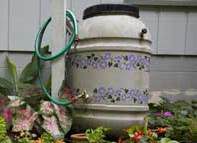
by Sheila Dunning | Feb 24, 2022
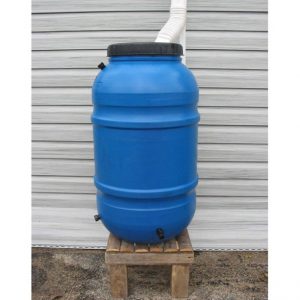
Rain Barrel made from food grade container.
A great way to save money on your water bill and reduce the amount of water withdrawn from the aquifer is to use a rain barrel. The water savings from using stored rainwater rather than municipal or well water can be substantial over a period of time. A rain barrel may not provide all the water needed to sustain all your plants, but it can certainly benefit some houseplants or even an entire vegetable garden. If you currently have a standard irrigation system, you may be able to turn off the sprinkler zones that are in flower beds and use stored rainwater instead.
Typically, the rain barrel is connected to the gutter downspout of the house. For a general calculation, you can collect about a half-gallon of water per square foot of roof area during a 1 inch rainfall. A typical ½ inch rainfall event will fill a 50-55 gallon barrel. Multiple rain barrels can be linked together with PVC or flexible hose to increase storage capabilities. However, with a screen modification on the lid, the rain barrel can be located anywhere in order to collect open rain fall. It will take a lot longer to fill, but may be more practical if the area you want to water is a good distance from the house.
Now is the time to prepare for the long, hot season to come. If you want to learn more, please join the Walton County Environmental Department and UF/IFAS at the Walton County Extension office on Monday, March 7, 2022 for an educational lecture on stormwater and demonstration on how to build a rain barrel. The first 20 participants may also sign up to build a take-home rain barrel. The program begins at 1:00 pm and is free to the public. Those interested in assembling a ready-to-go rain barrel will need to pay $35. Custom assembly will begin at 3:30 p.m. Please contact the Walton County Extension office to register. 850-892-8172.
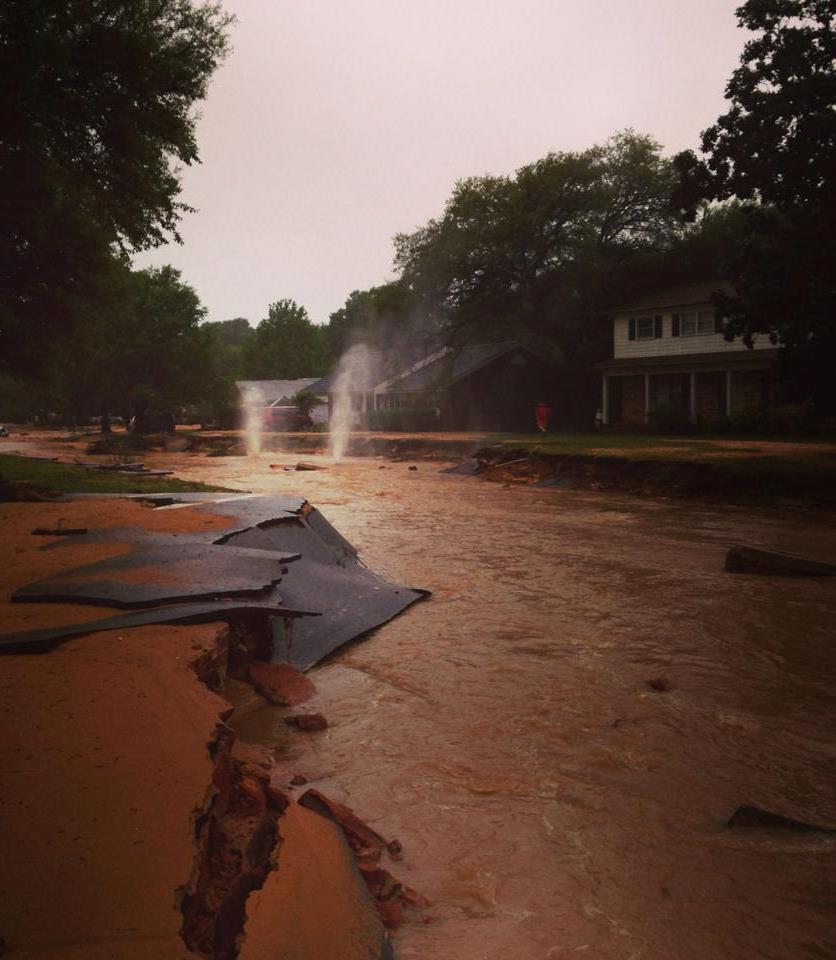
by Carrie Stevenson | May 6, 2015
Just over a year ago, southwest Alabama and northwest Florida experienced a devastating storm that left hundreds without access to their homes and businesses, flooded out and stranded by a hurricane-force storm that didn’t come with the luxury of a week’s warning. Rainfall records in Pensacola go back to 1879, and the April 29-30 storm broke them all, estimating just over 20 inches over the two days. Not only was the rainfall heavy, but the torrent was high in both velocity and volume—at one point, a mind-boggling 5.68 inches fell in the span of one hour. That’s half the annual rainfall of many cities in California and Texas!
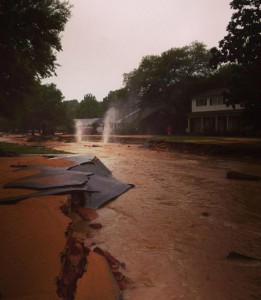
A residential street in Pensacola became a raging river a year ago during the torrential floods, putting dozens of people out of their homes. Photo credit: Carrie Stevenson UF/IFAS Extension.
With every dark storm cloud comes a silver lining, though, and just like the millions pumped into our regional economy from oil spill-related fines, the April 2014 floods have awakened a “greener” ethic among many residents, business owners, and politicians. According to a study just released by an environmental consulting firm, when asked about infrastructure changes and improvements to flooding and stormwater, attendees at community meetings overwhelmingly preferred “low impact” solutions such as expanded green space, cisterns, rain gardens, and stream restoration to “hard” structures such as bigger underground pipes and more pumps. While traditional engineering infrastructure is still crucial to a community that must maintain roads, stormwater ponds, and buildings, I find it encouraging that residents are interested in trying different techniques that have proven successful both here and in other parts of the world.
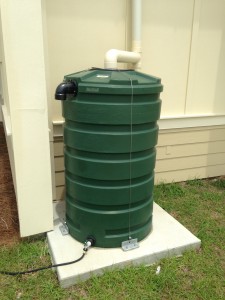
The new Langley Bell 4-H Center has four large rain barrels around the building, used to collect roof runoff for landscape design. Photo credit: Carrie Stevenson UF/IFAS Extension.
So, how does one prepare for unexpected rain and floods? The first thing is to realize that northwest Florida receives the most annual rainfall (over 60”) of any region of the state, and sometimes it seems to come down all at once. Preparing landscapes to handle both frequent and heavy rains is an important place to start. This article will begin a series of articles delving into those “low-impact” stormwater management techniques that can help lessen the impact of the intense storms we experience here in northwest Florida. Many of these practices, such as creating mulch pathways, harvesting rainwater, and installing shoreline vegetative buffers, can be implemented by individual homeowners and help reduce the impact of flooding on a neighborhood and city-wide level
by Matthew Orwat | Sep 15, 2013
Does Your Garden Irrigation Inflate Your Water Bill?
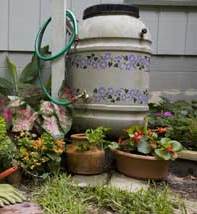
Image Credit: UF / IFAS
Flush High Irrigation Bills Down The Drain !
- Build A Rain Barrel
- Find Out How at our Workshop
- Saturday October 12th 2013 9am-12pm
- Location: Washington County Ag Center 1424 Jackson Ave
- UF / IFAS Washington County Extension 1424 Jackson Ave. Chipley, FL. East Wing Conference Room
You will engage in hands on construction of a rain barrel to take home and use to water your garden. All supplies will be furnished by the UF / IFAS Washington County Extension Master Gardeners at a cost of only $40.00 per person / barrel ! $10.00 to audit without barrel.
Call Matt or Cynthia at the Washington County Extension Office to
register at 850-638-6180 or email Matt at mjorwat@ufl.edu
or email Matt at mjorwat@ufl.edu
Master Gardner Advanced Training CEU’s offered with approval of your County Extension Agent
2013 Fall Rainbarrel Workshop Flyer

by Carrie Stevenson | Jul 7, 2013
Floridians use more water than any other state for irrigation, and a typical home sprinkler system can account for half of the cost and water use in a household during the summer.
One of the most convenient and efficient ways to conserve water is to install a rain barrel. Modern rain barrels involve ancient technology that relies simply on gravity, allowing stormwater to run from a rooftop into a gutter. The gutter funnels water into a plastic food-grade barrel or other container fitted with screen to keep out debris and insects. Most rain barrels also have an overflow device near the top (for heavy storms that might fill the barrel) and a spigot at the bottom for filling a watering can or attaching a hose. Keep in mind the barrels do not have a lot of pressure and cannot irrigate an entire lawn, but are ideal for vegetable gardens and container plants. Rain barrels vary widely in design, but they can be painted to add a decorative touch, or easily screened behind a shrub.
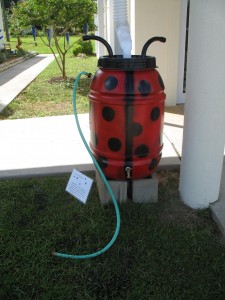
Building a rain barrel is a fun summer project for the whole family!
In addition to conserving water, rain barrels can be an effective means of reducing stormwater pollution. During a typical 1” rainstorm, an average home’s roof can yield 600 gallons of rainwater runoff that would normally flow downstream, picking up oils, greases, bacteria, trash, and pesticides along the way that end up in our water bodies. These pollutants eventually flow downstream to our creeks, bayous, and bays, contributing to non-point source pollution. Rain barrels interrupt that process by collecting stormwater runoff before it has a chance to pick up pollutants.
If you are interested in learning more about rain barrels or how to build your own, contact your local County Extension Office. Escambia County Extension will be hosting two rain barrel workshops this summer, the first on Friday, July 12 and the second on Saturday, August 3. There is a $42 charge for those wishing to build their own rain barrel after the workshop—all supplies and tools will be provided. To register for the full workshop, go online to the event registration website.
It is free to attend and hear the talk without building a barrel, but please reserve a spot by using the contact information below.










